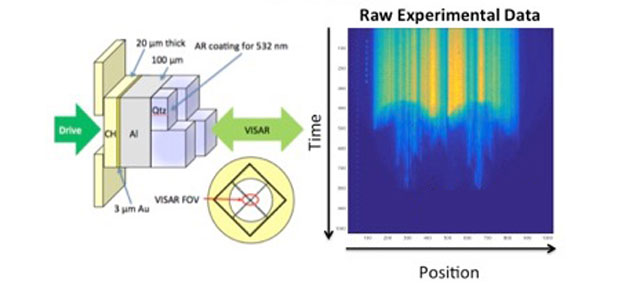Dayne Fratanduono (16-FS-022)
Project Description
Compressed ultrafast photography at one hundred billion frames per second is a new experimental technique that enables one to reconstruct three-dimensional (two spatial and one temporal) movies from a compressed two-dimensional image. Developing this technique would be a major improvement over framing cameras and the more recent dilation-x-ray imaging technique, called DIXI, that uses pulse-dilation technology. Compressed ultrafast photography would exceed the temporal resolution of the state-of-the-art framing cameras developed at Livermore’s National Ignition Facility by a factor of 2 and the number of recorded images by a factor of about 20. We are conducting a feasibility study to demonstrate that compressed ultrafast photography can be fielded at laser facilities and to test the recent claim that up to 350 frames per shot (with a 10-ps repetition rate) may be encoded on a single sweep. Awarded time on Livermore’s Janus laser and one day of basic science program time on the OMEGA EP (extended performance) laser at the University of Rochester in New York, we plan to implement the diagnostic on simple targets and explore the time and spatial resolution, dynamic range, and general applicability of the methodology on laser-driven experiments. We also plan to modify an existing diagnostic to examine the compressed ultrafast photography technique.
We are exploring the feasibility of measuring spatial and temporal resolution, dynamic range, and applicability to common laser-compression experimental targets using compressed ultrafast photography. Once we determine the applicability of the technique to dynamic laser-compression experiments through these measurements, we will be in a position to apply the technique to a variety of other experiments, including shadowgraphy (a method that reveals nonuniformities in transparent media), Schlieren imaging (visualizing density variations in transparent media), and Mack–Zehnder interferometry (measuring phase shifts between collimated beams) of microjets, strong-shock structure around impediments, focusing, and dilute-plasma structure. In addition, there is no fundamental limitation to using compressed ultrafast photography for visible-light imaging, and there may be the potential for using compressed ultrafast photography for x-ray imaging. The proposed diagnostic could enable ultrafast imaging to both temporally and spatially resolve the formation, growth, and propagation of jetting phenomena relevant to high-energy-density science (see figure).
Mission Relevance
This feasibility study supports Livermore’s core competency in high-energy-density science and strategic focus area in stockpile stewardship science by potentially verifying the utility of a new technology for studying the properties of matter under extreme conditions of temperature and pressure. Within the dynamic compression community, there is significant interest in understanding the formation, size, and distribution of ejecta. Compressed ultrafast photography may be an ideal diagnostic for understanding the relationship between shock-wave impulse and the geometric properties of microscopic and plasma jets.
FY16 Accomplishments and Results
In FY16 we (1) executed two experimental campaigns to examine the ultrafast imaging technique, (2) tested the technique at the JANUS laser facility, (3) built and implemented a new diagnostic at the OMEGA EP laser facility, and (4) collected data at both facilities. Preliminary analysis indicates that the technique was successful at creating the fastest two-dimensional shock movies ever recorded. However, significant work is needed to improve the analysis technique.






